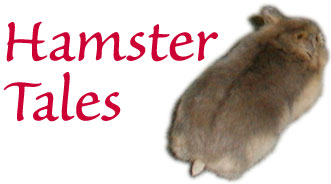|
Part 1: In which I discover the grandmother geneWhat led to my getting a hamster was working on a primary school article last spring on "How We Care for Our Pets." (I keep telling people my job has more hazards than just my falling off my wheeled desk chair.)  As some of you may know, my last pet -- some 30 years ago -- was Rover (known as Old Tire-biter by the neighbors), a pessimistic shepherd-coyote mutt who was usually found moping in the large hole that he'd dug under a magnolia tree, gnawing on a child's tennis shoe and a crutch, both of which he had brought home on different occasions. (I felt it was better not to ask questions.) When he was a puppy, I'd fed him a mix of canned and dry food, warmed to room temperature. In the end, though, I just tore open a bag of dry food and left it on the porch. He liked to nap with his nose in the bag, waking now and then for a mouthful of Kibble. The system worked for us, but it would be stretching a point to call it pet care, so I went on the Web to research the project. I found a promising site title on hamsters, and opened it to a pair of hands holding a startled-looking dwarf hamster, which should have been captioned: "For just $.89 a day little Sparky can eat." Up to this time, I was quite comfortable with the lack of the mothering gene on my particular strand of DNA, possibly because I was distracted by the I-really-have-to-have-that-pair-of-shoes gene that had obviously replaced it. The only way that I can explain what happened next was that the photo jump-started the grandmothering gene (which was probably where the oh-boy-let's-go-hiking-in-the-forest gene should have been). Called in to see the hamster photographs, Ted grunted unenthusiastically. I launched the "Why can't we have a hamster, just a little hamster, please, please..." campaign. Explaining that if I could not have a hamster, I could at least look at them, I posted photographs of Sparky and his pals in places where I could enjoy them: the refrigerator, the bathroom mirror, Ted's side of the bed, etc. Finally, I talked Ted into going to the pet store with me to at least look at the hamsters. I pointed out the 3-inch-long hamsters and said, "Now how much bother can a little hamster like that be?" Lack of experience made it impossible for him to come up with an answer to that... The next day I went back to the pet shop alone and was waited on by a young man, whom as it turned out you would not want to buy a used hamster from. He brought out a cardboard box teeming with hamsters (who have teeming down to an art, incidentally) and called my attention to one with a pronounced stripe. He urged me, "Take that one. It's one of the most sociable ones." At which point, that particular hamster darted forward and attacked two other hamsters in quick succession. I replied that I would prefer one a little more introverted, and I picked out a fat fellow with a lighter coat, who was in a meditative trance or semi-comatose. The clerk boxed my hamster while I bought two kinds of hamster chow, vitamins, treat sticks, specially shredded paper for the cage floor, a rolling ball, a twig nest, an extra drinking bottle, tubes to expand the hut I already had, and other hamster necessities. When I got home and opened the box to decant the hamster into Country-Club model habitat (comes with wheel, penthouse, and wet bar), I noticed -- before it bit me -- that it had a pronounced stripe down its back. The clerk had foisted Mr. Congeniality on me after all. The first night was a horror for us both. The hamster was scrabbling around the edges of its hut, trying to escape, and I was upstairs and wide awake, insisting, "I just know it's down there crying its little heart out." ("You are not bringing that rodent upstairs," said Ted.) |

